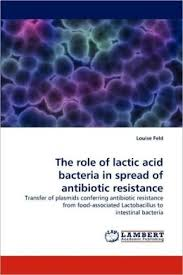Antibiotic resistance of lactic acid bacteria
Keywords:
Lactic acid bacteria, Antibiotic Resistance, ProbioticsAbstract
About 50 years ago, antibiotics were introduced for the treatment ofmicrobial diseases. Since then, the greatest threat to the use of antimicrobialagents for therapy of bacterial infections has been the development ofantimicrobial resistance in pathogenic bacteria. Lactic acid bacteria (LAB) area heterogeneous group of bacteria found widely in nature. They colonize thegastrointestinal and urogenital tracts of humans and animals, and are presentin foods such as dairy products, fermented meats, fruits and vegetables.Recently many investigators have speculated that commensal bacteria includingLAB may act as reservoirs of antibiotic resistance genes similar to those foundin human pathogens. The aim of this review is to consider the current evidenceon antibiotic resistance of lactic acid bacteria.References
Ammor, M.S., Flórez, A.B., Van Hoek, A.H.A.M., delos Reyes-Gavilan, C.G., Aarts, H.J.M., Margolles, A., 2008. Molecular charac-erization of intrinsic and acquired antibiotic resistance inlacticacid bacteria and bifidobacteria. J. Mol. Microbiol.Biotechnol., 14, 6–15.
Ashraf, R., Shah, N.P., 2011. Antibiotic resistance of probiotic organisms and safety of probiotic dairy products. Int. Food Res. J., 18(3), 837-853.
Bozdogan, B., Galopin, S., Leclercq, R., 2004. Characterization of a new erm related macrolide resistance gene present in probiotic strains of Bacillus clausii. Appl. Env. Microbiol., 70, 280– 284.
Carr, F.J., Chill, D., Maida, N., 2002. The lactic acid bacteria: a literature survey. Crit. Rev. Microbiol. 28, 281–370.
Cauwerts, K., Pasmans, F., Devriese, L.A., Martel, A., Haesebrouck, F., Decostere, A., 2006. Cloacal Lactobacillus isolates from broilers show high prevalence of resistance towards macrolide and lincosamide antibiotics. AvianPathol., 35, 160–164.
Didic, S., suskovic, J., Kos, B., 2008. Antibiotic Resistance Mechanisms in Bacteria: Biochem. Genetic Aspects. Food Technol. Biotechnol., 46 (1), 11–21.
Dimitris Charalampopoulos, R., Rastall, A., (Eds.); Prebiotics and Probiotics Sci.Technol. Spring. Sci., 2009. pp. 1-1273.
EFSA., 2007. Introduction of a Qualified Presumption of Safety (QPS) approach for assessment of selected microorganisms referred to EFSA. The EFSA J., 587, 1–16.
FAO/WHO., 2006. Probiotics in food. Health and nutritional properties and guidelines for evaluation. FAO Food Nutr., Pap, 85, 1–50.
Florez, A.B., Ammor, M.S., Alvarez Martín, P., Margolles, A., Mayo, B., 2006. Molecular analysis of tet(W)gene-mediated tetracycline resistance in dominant intestinal Bifidobacterium species from healthy humans. Appl. Env. Microbiol., 72, 7377–7379.
Galopin, S., Cattoir, V., Leclercq, R., 2009. A chromosomal chloramphenicol acetyl transferase determinant from a probiotic strain of Bacillus clausii. FEMS Micro biol. Lett., 296, 185–189.
Hummel, A.S., Hertel, C., Holzapfel, W.H., Franz, C.M., 2007. Antibiotic resistances of starter and probiotic strains of lacticacid bac-teria. Appl. Env. Microbiol., 73, 730–739.
Kazemi Darsanaki, R., Issazadeh, K., Khoshkholgh Pahlaviani, M.R.M., Azizollahi Aliabadi, M., 2012. Antimutagenic Activity of Lactobacillus spp. Isolated from Fresh Vegetables against Sodium Azide and 2-Nitrofluorene. J Pure Appl. Microbio., 6, 1677-1682.
Kazimierczak, K.A., Flint, H.J., Scott, K.P., 2006. Comparative analysis of sequences flanking tet(W) resistance genes in multiple species of gut bacteria. Antimicrob. Agents Chem., 50, 2632–2639.
Klare, I., Konstabel, C., Werner, G., Huys, G., Vankerckhoven, V., Kahlmeter, G., 2007. Antimicrobial susceptibilities of Lactobacillus, Pediococcus and Lactococcus human isolates and cultures intended for probiotic or nutritional use. J. Antim. Chem., 59, 900-912.
Lavanya, B., Sowmiya, S., Balaji, S., Muthuvelan, B., 2011. Screening and Characterization of Lactic Acid Bacteria from Fermented Milk. British. J. Dairy Sci., 2(1), 5-10.
Leroy, F., de Vuyst, L., 2004. Lactic acid bacteria as functional starter cultures for the food fermentation industry. Trends Food Sci. Technol., 15, 67–78.
Mathur, S., Singh, R., 2005. Antibiotic resistance in food lactic acid bacteria—a review. Int. J. Food Microbiol.,105, 281– 295.
Mayrhofer, S., vanHoeck, A.H.A.M., Mair, C., Huys, G., Arts, H.J.M., Kneifel, W., 2010. Antibiotic susceptibility of members ofthe Lactobacillus acidophilus group using broth micro dilution and molecular identification of their resistance determinants. Int. J. Food Microbiol., 144, 81– 87.
Munoz-Atienza, E., Gomez-Sala, B., Araujo, C., Campanero, C., del Campo, R., Hernandez, P.E., Herranz, C., Cintas, L.M., 2013. Antimicrobial activity, antibiotic susceptibility and virulence factors of Lactic Acid Bacteria of aquatic origin intended for use as probiotics in aquaculture. BMC Microbiol., 13, 1-22.
Patel, A.R., Shah, N.P., Prajapati, J.B., 2012. Antibiotic Resistance Profile of Lactic Acid Bacteria and Their Implications in Food Chain. World J. Dairy Food Sci., 7 (2), 202-211.
Perreten, V., Schwarz, F., Cresta, L., Boeglin, M., Dasen, G., Teuber, M., 1997. Antibiotic resistance spread in food. Nature., 389,801–802.
Rojo-Bezares, B., Saenz, Y., Poeta, P., Zarazaga, M., Ruiz-Larrea, F., Torres, C., 2006. Assessment of antibiotic susceptibility with in lactic acid bacteria strains isolated from wine. Int. J. Food Microbiol., 111, 234–240.
Suvarna, V.C., Boby, V.G., 2005. Probiotics in human health. A current assessment, Curr. sci., 88, 1744-1748
Tenover, F.C.,2001. Development and spread of bacterial resistance to antimicrobial agents: An overview. Clin. Infect. Dis., 33, 108–115.
Thumu, S.C., Halami, P.M., 2012. Presence of erythromycin and tetracycline resistance genes in lactic acid bacteria from fermented foods of Indian origin. Antonie Van Leeuwenhoek., 102, 541–551.
Van Hoek, A.H., Mayrhofer, S., Domig, K.J., Florez, A.B., Ammor, M.S., Mayo, B., 2008. Mosaic tetracycline resistance genes and their flanking regions in Bifidobacterium thermophilum and Lactobacillus johnsonii. Antimicrob. Agents Chem., 52, 248–252.
Zhou, J.S., Pillidge, C.J., Gopal, P.K., Gill, H.S., 2005. Antibiotic susceptibility profiles of new probiotic Lactobacillus and Bifidobacterium strains. Int. J. Food Microbiol., 98, 211-217.

Published
How to Cite
Issue
Section
Copyright (c) 2013 R. K. Darsanaki, M. A. Aliabadi, M.M. D. Chakoosari

This work is licensed under a Creative Commons Attribution-NonCommercial-NoDerivatives 4.0 International License.



